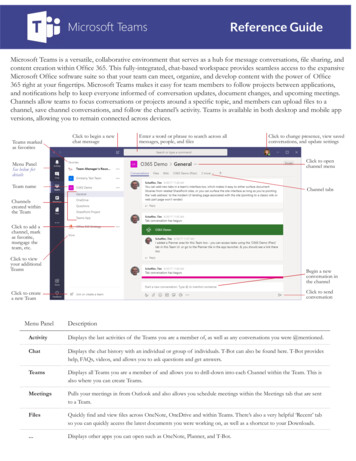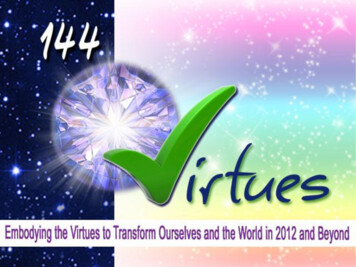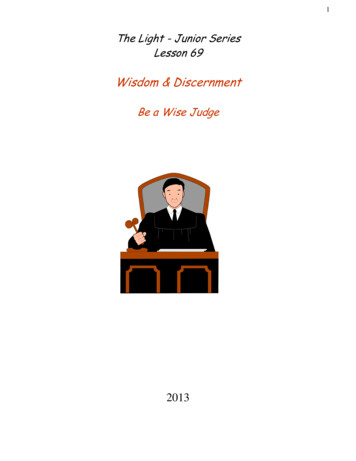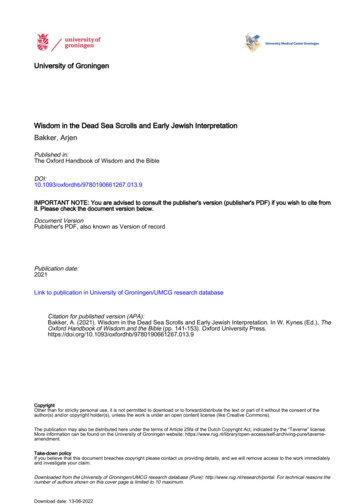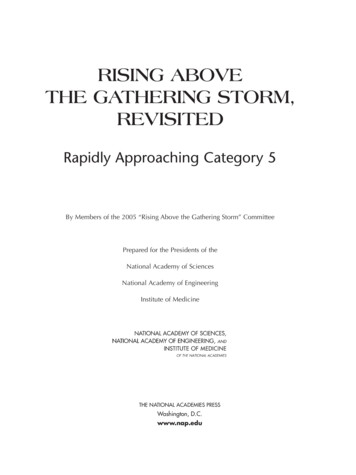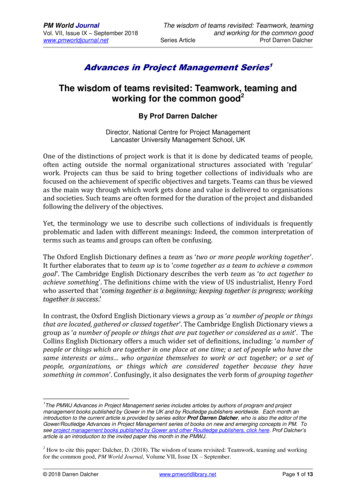
Transcription
PM World JournalVol. VII, Issue IX – September 2018www.pmworldjournal.netThe wisdom of teams revisited: Teamwork, teamingand working for the common goodSeries ArticleProf Darren DalcherAdvances in Project Management Series1The wisdom of teams revisited: Teamwork, teaming andworking for the common good2By Prof Darren DalcherDirector, National Centre for Project ManagementLancaster University Management School, UKOne of the distinctions of project work is that it is done by dedicated teams of people,often acting outside the normal organizational structures associated with ‘regular’work. Projects can thus be said to bring together collections of individuals who arefocused on the achievement of specific objectives and targets. Teams can thus be viewedas the main way through which work gets done and value is delivered to organisationsand societies. Such teams are often formed for the duration of the project and disbandedfollowing the delivery of the objectives.Yet, the terminology we use to describe such collections of individuals is frequentlyproblematic and laden with different meanings: Indeed, the common interpretation ofterms such as teams and groups can often be confusing.The Oxford English Dictionary defines a team as ‘two or more people working together’.It further elaborates that to team up is to ‘come together as a team to achieve a commongoal’. The Cambridge English Dictionary describes the verb team as ‘to act together toachieve something’. The definitions chime with the view of US industrialist, Henry Fordwho asserted that ‘coming together is a beginning; keeping together is progress; workingtogether is success.’In contrast, the Oxford English Dictionary views a group as ‘a number of people or thingsthat are located, gathered or classed together’. The Cambridge English Dictionary views agroup as ‘a number of people or things that are put together or considered as a unit’. TheCollins English Dictionary offers a much wider set of definitions, including: ‘a number ofpeople or things which are together in one place at one time; a set of people who have thesame interests or aims who organize themselves to work or act together; or a set ofpeople, organizations, or things which are considered together because they havesomething in common’. Confusingly, it also designates the verb form of grouping together1The PMWJ Advances in Project Management series includes articles by authors of program and projectmanagement books published by Gower in the UK and by Routledge publishers worldwide. Each month anintroduction to the current article is provided by series editor Prof Darren Dalcher, who is also the editor of theGower/Routledge Advances in Project Management series of books on new and emerging concepts in PM. Tosee project management books published by Gower and other Routledge publishers, click here. Prof Dalcher’sarticle is an introduction to the invited paper this month in the PMWJ.2How to cite this paper: Dalcher, D. (2018). The wisdom of teams revisited: Teamwork, teaming and workingfor the common good, PM World Journal, Volume VII, Issue IX – September. 2018 Darren Dalcherwww.pmworldlibrary.netPage 1 of 13
PM World JournalVol. VII, Issue IX – September 2018www.pmworldjournal.netThe wisdom of teams revisited: Teamwork, teamingand working for the common goodSeries ArticleProf Darren Dalcheras ‘a number of things or people that are together in one place or within oneorganization or system’.The Merriam-Webster English Dictionary offers a more comprehensive definition of agroup encompassing: ‘two or more figures forming a complete unit of composition; anumber of individuals assembled together or having some unifying relationship; anassemblage of related organisms—often used to avoid taxonomic connotation when thekind of degree of relationship is not clearly defined.The terms team and group are often used interchangeably. So, are the terms reallyexchangeable or is there a fundamental distinction between them?The difference between groups and teamsIn reality there are some subtle, as well as many clear distinctions. In a nutshell,individuals in groups work independently addressing their own agenda and priorities,whilst teams tend to collaborate on a single purpose or overarching goal. Groups maycoordinate the individual efforts, whilst teams collaborate on achieving their commonpurpose often displaying mutual commitment. Teams bring together a range ofexpertise and capabilities needed to combine and deliver meaningful results and oftenextend beyond organisational silos or functional structures. Teams are also more likelyto be employed on temporary endeavours, providing a focused and cross-functionalorientation supplemented by closer relationships and a sense of community. The resultcan be viewed as the ability to emphasise communal performance rather than celebrateindividual achievements (Dalcher, 2016a; p. 2).Teams often develop a collective identity and a greater responsibility for one anotherwhilst supporting the wider group. Members are interdependent acting out of collectiveinterest and maximising the greater good by focusing on the main goal and keyobjectives. Team members develop a deeper mutual understanding that enables them tomaximise the interest of the collective, with high performing teams benefitting from thesynergistic impacts of the assembled team.Scottish-American philanthropist and industrialist, Andrew Carnegie determined that‘Teamwork is the ability to work together toward a common vision. The ability to directindividual accomplishments toward organizational objectives. It is the fuel that allowscommon people to attain uncommon results.’Katzenbach and Smith (2015) conclude that teams should be the basic unit oforganisation for most businesses to enable them to achieve highest levels ofperformance, especially as teamwork integrates performance and learning. In their bestseller that has sold over half a million copies, Katzenbach and Smith further confirmthat commitment to performance goals and common purpose is more important to teamsuccess than team building and establish that real teams are the most importantspearheads of change at all levels. 2018 Darren Dalcherwww.pmworldlibrary.netPage 2 of 13
PM World JournalVol. VII, Issue IX – September 2018www.pmworldjournal.netThe wisdom of teams revisited: Teamwork, teamingand working for the common goodSeries ArticleProf Darren DalcherTeams take time to form and learn to perform together. As each team is made of acollection of individuals, it is subject to their relationships, internal dynamics andwillingness to co-operate and collaborate. Katzenbach and Smith (2015) note that allteams must shape their own purpose, performance goals and approach. Groups don’tbecome teams just because that is what someone calls them: The best teams invest alarge amount of time in shaping their own purpose that they can own and translate thatpurpose into specific performance goals so that members can become accountable withand to their own teammates (Katzenbach and Smith, 2008).The dynamic dysfunctions of teamsUltimately, an effective team is worth more than the sum of its parts; yet, not all teamssucceed all the time. According to Scoro (2017), 75% of cross-functional teams aredysfunctional. In the book, the five dysfunctions of a team, which has sold over twomillion copies, Lencioni (2006) highlights the root causes of politics, inability to deliverand dysfunctions of teams as the key problems plaguing teams that underperform—slightly paraphrased below—as:Absence of trust: The fear of vulnerability in front of other team members prevents thebuilding of trust within the teamFear of conflict: Productive conflict is avoided in order to preserve an artificialharmonyLack of commitment: The absence of buy-in from the team, or the lack of clarity aboutobjectives, prevents team members from making crucial decisions needed to supportand deliver the missionAvoidance of accountability: In order to avoid interpersonal discomfort teammembers do not hold each other accountableInattention to results: The pursuit of individual goals, agendas and personal statuserodes the focus on collective and ultimate successTeamwork has the potential to become a sustainable competitive advantage thatorganisations can control. Indeed, overcoming the dysfunctions is possible. Teams aredesigned to achieve the results they set out to achieve. Improving team performancerequires attention and effort to address the key dysfunctions. Teams that perform welldisplay a more advanced set of teamwork characteristics. In particular, Lencioni (2005;p. 7) notes the following (summarised and slightly paraphrased) aspects: Team members trust one another and are comfortable being vulnerable witheach other about their weaknesses, mistakes, fears, concerns and behaviours;they are also happy to tap into each other’s skills, expertise and experienceBecause they trust each other, team members can engage in passionate dialoguearound critical issues and decisions 2018 Darren Dalcherwww.pmworldlibrary.netPage 3 of 13
PM World JournalVol. VII, Issue IX – September 2018www.pmworldjournal.net The wisdom of teams revisited: Teamwork, teamingand working for the common goodSeries ArticleProf Darren DalcherBy being open and engaging in dialogue, they are able to achieve genuine buy-in,even following initial disagreementsAs they commit to making decisions, team members are confortable holding eachother accountable, instead of relying on the team leader as the main source ofaccountabilityThey are therefore more likely to set aside their individual agendas and needs,and focus instead on doing what is needed to secure team successLencioni suggests that the first key question to ask is ‘are we really a team?’:‘Sometimes a team improvement effort is doomed from the start because the group goingthrough it isn’t really a team at all You see a team is a relatively small number of peoplethat shares common goals as well as rewards and responsibilities for achieving them.Team members readily set aside their individual or personal needs for the greater good ofthe group.’ (Lencioni, 2005; p. 9)The second question is; ‘are we ready for the heavy lifting?’.Teams have great advantages, but they can only be achieved through commitment andinvestment from the individual members.In subsequent work, Lencioni (2016) concludes that the ideal team player has threemajor traits or virtues that impact the team’s success: humility, hunger and peoplesmarts. This combination of traits distinguishes individuals capable of contributing to ateam effort and accelerates the process of building high performing teams.The return of trustFrom the early cave dwellers and hunter-gatherers, humans have long understood thevalue of collaboration. Collaboration emphasises the purposeful nature of a partnershipwhere all parties strategically elect to cooperate in order to attain a mutually desirableoutcome or a particular benefit (Dalcher, 2016b; p. 1). However, the design of the ideal,or the perfect team, requires deeper consideration of the qualities of participants.Improving the performance of teams is a life-long mission for many organisations.Google has invested a small fortune in trying to optimise their internal teams. Theirworking assumption was that creating the best teams would require bringing togetherthe best individuals and matching their skills. Google measures most aspects of theiremployees’ lives. In 2012 they launched Project Aristotle, interviewing hundreds ofindividuals working in over 200 teams across the organisation. While they recordedindividual traits, skills and team habits, the results did not yield any insights regardingthe perfect mix required to underpin the best teams. Having discovered no discerniblepatterns, the group turned to group norms, the traditions, behavioural standards andunspoken rules that are used by teams. Yet, even the group norms seemed inconsistentacross the different teams, until the researchers stumbled upon the concept ofpsychological safety identified by Professor Amy Edmondson from Harvard BusinessSchool. Psychological safety refers to the shared belief that the team provides a safeenvironment for interpersonal risk taking; a team climate characterised by 2018 Darren Dalcherwww.pmworldlibrary.netPage 4 of 13
PM World JournalVol. VII, Issue IX – September 2018www.pmworldjournal.netThe wisdom of teams revisited: Teamwork, teamingand working for the common goodSeries ArticleProf Darren Dalcherinterpersonal trust and mutual respect in which team members feel empowered tospeak, question decisions and participate without fear of being judged or punished.Psychological safety allows team members to share personal insights as well as feelings,thoughts and concerns. Psychological safety relies on trust between team members asthe most fundamental ingredient in collective endeavours (Dalcher, 2017; p. 1). Whenrevisiting the data, Google discovered that the best teams provided a safe space formembers to talk to each other, listen and share.Google now defines psychological safety as the most important factor in building asuccessful team. It is less to do with how the team is put together, or the identity of themembers, and more with how the members interact with and relate to one another andis viewed as making the greatest difference to team dynamics.The five key dynamics identified as essential to team performance by the Googleresearch team are described below (Rozovsky, 2015):Psychological safety: Team members feel safe to take risks and be vulnerable in frontof each otherDependability: Team members count on each other to get thing doneStructure & clarity: Team members have clear roles, goals, and execution plansMeaning of work: Work is personally important to team membersImpact of work: Team members believe their work is significant and creates changeWhile all factors are viewed as important, psychological safety underpins the other fourand is essential in enabling the team to perform effectively and succeed.‘A team is not a group of people who work together. A team is a group of people who trusteach other.’ – Simon SinekRobbins & Finley (2000; p. 156) used the metaphor of blood to represent the criticalimportance of trust in teams: ‘Trust is the blood of teams. The river that carries it along,that pulses with life, that brings thought and power to everything the team attempts.’Who is packing your parachute?Trust is an essential to developing, growing and sustaining teams. Reflecting on hisexperience as the commander of the US forces in Afghanistan in the mid-2000s, GeneralStanley McChrystal devised the notion of Team of Teams (McChrystal et al., 2015).McChrystal discovered himself facing an enemy organised in flat networks that enabledit to regularly change, adapt and reconfigure itself. To combat the enemy, McChrystalinvestigated the ideas of complex systems and thereby recognised the need to transit 2018 Darren Dalcherwww.pmworldlibrary.netPage 5 of 13
PM World JournalVol. VII, Issue IX – September 2018www.pmworldjournal.netThe wisdom of teams revisited: Teamwork, teamingand working for the common goodSeries ArticleProf Darren Dalcherfrom a fixed and cumbersome traditional military hierarchy towards a set of dynamicteams operating as high performance teams.McChrystal synthesised his (slightly paraphrased below) principles for creating highpreforming adaptive teams as having: A clear and common purposeThe Freedom to speak your mindThe ability and trust to make decisionsA shared consciousness around value and what ‘good’ looks likeTrust in the capabilities, knowledge and intentions of other membersLeading like a gardener by focusing on the creation of a nurturing and supportiveenvironment in which good work can take place, without the need to taskmanageThe power of teams is also reflected in having the ability of different members of theteam to deal responsibly with all the required aspects and prepare for the normalcontingencies of any situation.Joseph Charles Plumb was a US Navy jet pilot during the Vietnam War, who successfullycompleted 75 successful combat missions. On his next mission, he managed to bail outjust before his plane was hit by a surface-to-air missile. He parachuted into enemyterritory and was captured and held in a prisoner of war camp for over six years.Years later he was dining in the US with his wife, when a man seated at another tablecame over and said ' You're Plumb! You flew jet fighters in Vietnam from the aircraftcarrier Kitty Hawk. You were shot down!Plumb was intrigued and asked ‘how in the world, did you know that?”‘I packed your parachute’, the stranger replied.Plumb jumped up in surprise and hugged the man.‘I guess it worked’, the stranger continued.Plumb was quick to reassure him: ‘It sure did. If your chute hadn’t worked I wouldn’t behere today’.Plumb spent the next sleepless night reflecting on the stranger who saved his life. As afighter pilot he would have ignored the mere sailor in a white uniform. The sailor musthave spent many hours in the bowels of the ship folding the silk parachutes overwooden desks. Yet, Plumb was grateful for his dedication and ability to carry out hisduties in a professional manner. Plumb also recognised that he needed many differentparachutes to get through his ordeal, including his physical parachute, as well as amental parachute, emotional parachute and spiritual parachute. 2018 Darren Dalcherwww.pmworldlibrary.netPage 6 of 13
PM World JournalVol. VII, Issue IX – September 2018www.pmworldjournal.netThe wisdom of teams revisited: Teamwork, teamingand working for the common goodSeries ArticleProf Darren DalcherWe all have team members, and indeed other support teams who provide specialistservices acting for the greater good. We often take their presence and good will on trust.We never hear about them precisely because, things often work out as intended. If weget to know them, or hear about them, it is probably because some thing went wrong.Their success criteria may well be to ‘never make the news’ (i.e. always delivering aservice that does not draw attention to itself through failure or absence).We could look around us and try to reflect on all the teams and unsung heroes thatsilently provide uninterrupted and perfectly reliable parachute services. Indeed, it is asobering thought to ask yourself periodically ‘who is packing my parachute?’Creative teamsWhat about the success of teams?The work context is becoming increasingly more challenging as professionals and teamsencounter a faster changing world replete with seemingly unprecedented levels ofuncertainty, turbulence, novelty, and ambiguity. Moreover, the complexity of manyundertakings is also on the increase requiring faster learning, skilful adaptation andwell considered experimentation. The implication is that to operate successfully, teamswould require greater flexibility, an expanding diversity of potential responses andamplified agility and resilience skills that underpin their abilities to explore, make senseof, respond to and benefit from variations, change and opportunities.A recent article in the Harvard Business Review reasons that cognitive diversity in ateam leads to speedier problem solving. Reynolds and Lewis (2017) have studied howwell executive teams could complete a strategic execution task under time pressure.Their conclusion is that diversity in age, ethnicity and gender has little, if any, impact ona team’s ability to navigate complex or novel situations. However, the cognitivediversity, which they define as the ‘differences in perspective or information processingstyle’ (Ibid; p. 2) is critical to dictating how successful a given team would be at solving aproblem.The early results from the 12-year study indicate that diverse teams, involving a mix ofthinking styles outperformed mentally homogenous teams. Indeed, some of the teamswhere all members had the same thinking style never finished the task. Reynolds andLewis conclude that ‘tackling new challenges requires a balance between applying whatwe know and discovering what we don’t know that may be useful. It also requiresindividual application of specialised expertise and the ability to step back and look at thebigger picture.’ (ibid.; p. 4)Homogenous teams will tend to apply similar logic and fail to identify and utilisealternative resolution approaches and diverse perspectives, which could be limiting,particularly in challenging contexts and novel situations. A high degree of cognitivediversity allows exploration of alternative routes and methods and the introduction ofalternative perspectives and considerations whilst also generating accelerated learningand improved performance. 2018 Darren Dalcherwww.pmworldlibrary.netPage 7 of 13
PM World JournalVol. VII, Issue IX – September 2018www.pmworldjournal.netThe wisdom of teams revisited: Teamwork, teamingand working for the common goodSeries ArticleProf Darren DalcherPeter Cook, our guest author is also concerned about the new dimensions of change inmodern contexts. His contribution is developed from his recent book Brain BasedEnterprises: Harmonising the Head, Heart and Soul of Business, published by Routledge.Cook draws upon his unique expertise as a leader of Human Dynamics, a creativity andinnovation consultancy, his research career as the leader of global medical researchteams and the creator of the Academy of Rock, fusing business leadership with music.With his unique background and reputation as an innovator and deep thinker, Cook isboth an agent provocateur, constantly challenging the status quo, and the epitome ofcognitive diversity enabled through the blending of different approaches andperspectives for viewing the world.In an increasingly demanding world, Cook views intelligence, ideas and innovation asthe three core currencies of sustainable progress which can be harnessed to encourageimprovement. He identifies an unprecedented level of convergence between humanityand technology introducing a new level of man-machine dynamic. The convergencerequires a rethinking of the relationship and adjustments to the practices we apply inthe real world. His approach is to emphasise the role of brainy people, brainy teams andbrainy enterprises, and his current contribution is focused on the role and impact ofbrainy teams. The distinction also allows Cook to address different levels of capability,which he positions as personal intelligence, collective intelligence and globalintelligence. He thus offers a new level of diversity alongside a sensitivity to the abilitiesof people in teams and enterprises and a keen interest in augmenting and fusingcapabilities with new technologies.Cook addresses some of the key topics in teams including levels of connectedness, teamdiversity, team chemistry and team transparency often re-focusing attention aroundcollaboration in innovative activities and novel contexts. Teams can make themselvesmore intelligent (and increase their diversity) through networking and leveraging theirknowledge, expertise, connections and experiences. Leading teams in the age ofintelligence requires new skills of facilitation, engagement and influencing (Cook, 2018;p. xiv). At the enterprise level there is also a greater need for improvisation, agility andresponsiveness – and the liberation of the head, heart and soul, inspired by ideas fromthe art world.Not surprisingly, Cook agitates for a more responsible agenda, both in terms of ourinteractions with machines and technology, as well as the social and sustainabledimensions of our actions. As part of his wider agenda he advocates the replacement ofMichael Porter’s notion of competitive advantage with the idea of sustainable coopetiveadvantage through the incorporation of aspects of cooperative behaviour andsustainability considerations. The idea of intelligent teams can thus be offered as a newfoundation for considering the power and success of teams through encouraging a newemphasis on cooperation, collaboration, sharing and increased knowledge assets,perspectives and capabilities available for teams to utilise. The result may well be thecreation and development of more effective and better-informed teams capable ofdelivering in and responding to our rapidly changing world. 2018 Darren Dalcherwww.pmworldlibrary.netPage 8 of 13
PM World JournalVol. VII, Issue IX – September 2018www.pmworldjournal.netThe wisdom of teams revisited: Teamwork, teamingand working for the common goodSeries ArticleProf Darren DalcherTeaming for successHarvard Business School professor, Amy Edmondson maintains that organisationalsuccess and failure is dependent on a team’s ability to ‘team’ – to learn and adapt to theenvironment and each other. She offers the example of the Water Cube, the magnificent340,000 square foot box framed in steel and covered with semi-transparent, ecoefficient blue bubbles, hosting the swimming and diving events at the Beijing 2012Olympic Games. The water Cube won prestigious engineering and design awards andcost an estimated 10.2 billion Yuan.‘The goal was clear: Build an iconic structure to reflect Chinese culture, integrate with thesite, and minimize energy consumption—on time and within budget. But how to do it allwas less clear’ (Edmondson, 2012; 72-74).Increasingly demanding challenges call for new approaches and new levels ofengagement. Tristram Carfrae, an Arup structural engineer based in Sydney broughttogether a team of experts from 20 disciplines and four countries to deliver the specialbuilding. However, the undertaking required new approaches to managing projects andteams.‘Success depended on bridging dramatically different national, organizational andoccupational cultures to collaborate in fluid groupings that emerged and dissolved inresponse to needs that were identified as the work progressed’ (Edmondson, 2012; 74).Instead of using established teams, the strategy called for teaming; gathering experts intemporary groups as needed to solve problems as and when they emerge. The leader’sjob under such circumstances is not to manage the team, or support it, but to inspireand enable teaming in the right configurations needed to progress the joint purpose.Teaming can therefore emerge and evolve as members, specialists and stakeholders pulltogether and respond to what arises from the targeted pursuit of the intended purpose.Teaming is not a noun but a new way of life, a continuous effort to undertake andcomplete a bigger and more complex undertaking that can only be understood as thedetails emerge and the opportunities are explored. Teaming implies a constantlyshifting membership, albeit with a diversity of perspectives as necessitated by theconditions uncovered and the ideas being pursued.Edmondson advocates a move from teams to ‘teaming’, replacing stable project teamswith a flexible form of teamwork, by gathering diverse experts from different domainsand specialisms into temporary groups to address emerging progress, problems andopportunities and enable a form of learning as we progress.‘Teaming helps individuals acquire knowledge, skills and networks. And it lets companiesaccelerate the delivery of current products and services while responding quickly to newopportunities, Teaming is a way to get work done while figuring out how to do it better;it’s executing and learning at the same time.’ (ibid.,; 74). 2018 Darren Dalcherwww.pmworldlibrary.netPage 9 of 13
PM World JournalVol. VII, Issue IX – September 2018www.pmworldjournal.netThe wisdom of teams revisited: Teamwork, teamingand working for the common goodSeries ArticleProf Darren DalcherTeaming is ideal for complex, uncertain, novel and turbulent settings, where immenselevels of learning and sense making are needed. It fosters diversity of perspectives andapproaches by considering ideas from multiple domains and areas and enables betterinformed and more inclusive and intelligent solutions to be proposed, trialled andimplemented.The key challenges in teaming (paraphrased from, Edmondson, 2012; p. 78) are: Multiple functions must work together; so conflict may arisePeople are geographically dispersed; so communication difficulties and timezone differences present logistical difficultiesRelationships are temporary; so there is little time to build trust and mutualunderstandingNo two projects are alike; so no precedents existThe work can be uncertain and chaotic; so fluid situations are in need of constantcommunication and coordinationNonetheless, the potential benefits are also enormous and include (ibid.): Innovation from combined skills and perspectivesBoundary spanning solutionsDeveloping an understanding of other disciplinesBroader perspectiveGreater alignment across divisionsExtensive networks of collaborationsAbility to meet changing customer needsFlexibility and agilityAbility to import ideas from other contextsAbility to manage unexpected eventsExperimentationThe key principles required for successful teaming would be quite familiar (adaptedfrom, (ibid.; 80-81)):Emphasising purpose: By articulating what is at stake, particularly for diverse andwide-ranging teaming arrangementsBuilding psychological safety: Required to enable rapid sharing and trust buildingEmbracing failure: Novelty courts failures as well as new learning opportunitiesPutting conflict to work: Diversity will foster differences and conflict can be used totease out new ideas and perspectives 2018 Darren Dalcherwww.pmworldlibrary.netPage 10 of 13
PM World JournalVol. VII, Issue IX – September 2018www.pmworldjournal.netThe wisdom of teams revisited: Teamwork, teamingand working for the common goodSeries ArticleProf Darren DalcherTEAM Together Everyone Achieves MoreThe value of teams and their key contribution can be summarised through a number ofquotes:‘We talk a lot about hope, helping, and teamwork. Our whole message is that
The dynamic dysfunctions of teams Ultimately, an effective team is worth more than the sum of its parts; yet, not all teams succeed all the time. According to Scoro (2017), 75% of cross-functional teams are dysfunctional. In the book, the five dysfunctions of a team, which has sold over two

